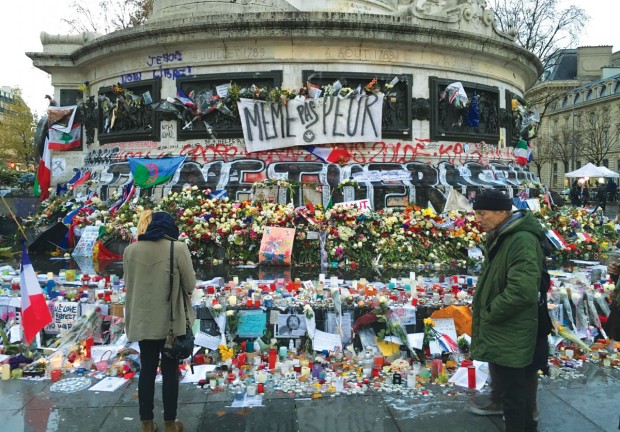City of Light
Visiting Paris after the attacks

A massive display of flowers and candles at a monument in La République honor those who died in the Nov. 13 terrorist attacks in Paris. (Photo: Morgan Bernard)
As I waited at my gate, I stared at the boarding pass that read “Charles De Gaulle International Airport: Paris.” Paris: one of the great cities of the world, a mecca for the arts, and a symbol of Western progression.
What an opportunity it was to be able to travel to Paris. I had visited once before, after graduating high school. But this time the date was Nov. 22, 2015. A little more than a week had passed since terrorist attacks in multiple Paris locations had left 129 dead and hundreds wounded.
Was the Paris I was headed for the same Paris that existed before?
I arrived early in the morning after flying through the night. The first thing I noticed was the increased security at Charles De Gaulle. Armed French troops roamed the airport. I shook off encroaching jet lag and hopped in a taxi to meet Camille Le Gardeur, my girlfriend, fellow Sewanee student and unofficial tour guide, who had been studying in Paris for the semester.
Our first day was filled with the typical tourist checklist: the Musée d’Orsay, the Notre Dame cathedral, the Arc de Triomphe and seasonal Christmas markets. In each location, I witnessed the same scene from the airport: armed troops policing the public. Was this Paris’s future?
It wasn’t until that night that I saw a different response to the deadly acts of hate. We returned to the Arc de Triomphe to climb to the top and view the city. From the top, we gazed through rain and fog and looked upon the city of Paris. The harsh weather could do nothing to deter the spectacular view. My eyes were immediately drawn to the Eiffel Tower. The tower was lit up in the red, white and blue colors of the French flag.
As we walked around the Arc, we could see that the Eiffel Tower was not the only display of French patriotism. The Ferris wheel that marked the Christmas markets glowed red, white, and blue, as did the French National Assembly building. As I walked along the Seine River the next day, I saw artisans and newsstands displaying French flags of all sizes for sale.
The next night, Camille and I found ourselves in La République, the neighborhood that was the site of the majority of the attacks. Just as the sun tucked itself away behind the Western portion of the city, we arrived at the monument in the center of La République.
There we found a massive display of mourning and remembrance. The statue at the center of the square was covered in banners, flowers, candles and framed pictures. A large crowd had gathered around the memorial to pay their respects in the form of a candle lighting. The square, which is usually filled with the hustle of city children playing soccer and tourists taking pictures, was overwhelmed by emotion. Feelings of solidarity and pride outweighed the grief that one might have expected to find.
I spoke with several Parisians at the memorial. A young man named Traore Alpha said, in French, that the attacks were, “tragic, because all of France is concerned. But the entire country is concerned together.” Traore said he was a Muslim, and that “men who are killing and using religion to justify it” didn’t make sense to him. “It’s not religion,” he said with vigor.
A young woman named Camille Chapin-Derennes told me that she was a Red Cross volunteer, and that on the night of the attacks, she helped care for the wounded. “Responses such as these, with flowers, and of remembrance are very important,” she said. Responding to hate with love, she said, “is absolutely effective.” She said education is the only way to battle intolerance.
From this experience I realized that the Parisian response to the tragedy had little to do with military presence and everything to do with pride, love and solidarity. In time the troop presence will dwindle, and Paris will keep being Paris. No matter what is thrown at it.
Editor’s note: Morgan Bernard is a 22-year-old senior at Sewanee: The University of the South, a graduate of Houston’s St. John’s School and a former summer intern at The Buzz Magazines.
Want more buzz like this? Sign up for our Morning Buzz emails.
To leave a comment, please log in or create an account with The Buzz Magazines, Disqus, Facebook, or Twitter. Or you may post as a guest.


